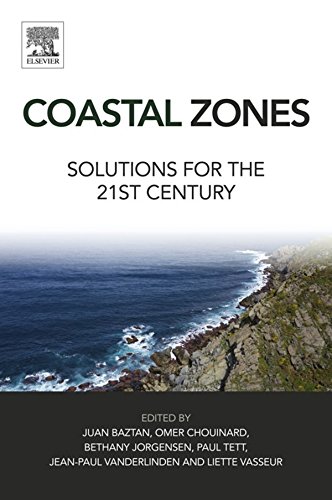Publication Announcement: «Coastal Zones - Solutions for the 21st Century»

«Coastal Zones - Solutions for the 21st Century» that Juan Baztan and Jean-Paul Vanderlinden co-edited with other international colleagues Omer Chouinard, Bethany Jorgensen, Paul Tett and Liette Vasseur, has just been released.
Introduction
Coastal zones, the narrow transition areas that connect terrestrial and marine environments, are our planet’s most productive and valued ecosystems (Crossland et al., 2005). Sixty percent of the world’s major cities are located in coastal zones, and 40% of the all the people on the planet live within 100km of a coastal zone (Nicholls et al., 2007). Within coastal areas, we see the tightly intertwined relationships between humans and coastal resources amplifying the most urgent questions of limits and equilibrium, sustainability, and development in our world today.
Over the past 25 years, efforts have been made to understand and improve the relationships between our societies and our coastal ecosystems. They have led to more than 100 national and transnational coastal zone plans, protocols, and conventions. Nevertheless, we realize the balance between development and stewardship still tilts toward development. Many more efforts are needed to restore harmony between use and conservation of coastal zones. Furthermore, most advances have been driven top-down, often with scant regard for grassroots interests.
In November 2011, the “Coastal Zones: 21st Century Challenges” working group, a consortium of academics and members of research centers across the globe, collected 115 points of view and synthesized them into one document addressed to delegates attending the Rio+20 Conference held in Brazil in June 2012. This baseline document represented the interdisciplinary collaborative work of more than 200 coastal zone researchers from all continents (see Appendix). The idea for this book grew from seeds planted by the baseline document, and it was nourished through subsequent workshops organized by the working group.
Rooted in the baseline document, our objectives for this book are to: (1) highlight the looming challenges facing coastal zones around the world and (2) explore potential solutions from the perspective of the scientific and technological community, as part of the effort to construct and achieve the Rio+20 goals and soon to come, the proposed Sustainable Development Goals (SDGs). Indeed, among the proposed SDGs, Goal 14 is of particular importance to us: Conserve and sustainably use the oceans, seas, and marine resources for sustainable development. Several others are also directly or indirectly connected to our work and dialog.
This book links perspectives from regional, national, and international efforts with local needs for actions in communities where coastal zone challenges are faced daily. It is designed for a diverse audience that encompasses academics and “on the ground” practitioners and community stakeholders. Stakeholders and practitioners need to know how to reach their groups or communities, how to involve them in finding long-term solutions, how to identify underlying issues and understand how problems are integrated in order to determine a path forward, and so forth. We hope you will gain new insight from our unique effort to compile and connect present challenges and possible solutions from different locations around the world, as opposed to focusing on one single region.
For students, this book provides an invaluable reference to better understand the steps of Integrated Coastal Zone Management, from problem description to potential approaches to solutions, and to see how these steps can be implemented in communities. From this book, students will learn the pros and cons of various approaches, understand the issues from an interdisciplinary point of view, and find new ideas for projects and research.
In our experiences as professors, researchers, and practitioners, there are few textbooks on Integrated Coastal Zone Management that adopt a transdisciplinary approach—by which we mean one that draws on stakeholder knowledge and interpolates it with perspectives from the natural and social sciences to provide a basis for the co-development of an effective understanding of socioecological systems in the coastal zone. We aim to provide a broad perspective and to consider not only problems but also approaches that may lead to solutions. With “wicked” problems like those facing coastal zones, it is easy to find literature that highlights the intractability of the challenges we face. It is much harder to find research concerning potential solutions to help communities and stakeholders. This work aims to help fill that crucial gap.
We would like to take a moment to acknowledge the many people who have brought this book to fruition. It is a truly interdisciplinary collaborative work, and we sincerely thank those whose input, encouragement, and effort have made it possible. From the “Coastal Zones: 21st Century Challenges” working group members, to the contributing authors for their inspiring work, to the communities who have worked with and supported us, as well as the publishing team at Elsevier, especially Candice Janco and Marisa LaFleur, with their unfailingly polite attempts to keep us on track, and Mohanapriyan Rajendran and his production team. Thank you all for your contributions to and patience with the process.
By presenting a wide range of approaches to the challenges coastal zones face in the twenty-first century, this book will expand your “toolkit” for collaboratively transforming coastal communities and ecosystems to achieve a more sustainable future. We hope it inspires you to engage these challenges in new ways, with renewed vigor. As a colleague recently said, “Let’s do the work―that’s the only solution.”
For more information see: http://www.sciencedirect.com/science/book/9780128027486



